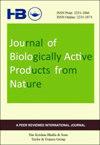遗传稳定药用植物姜黄离体叶片生物量快速生产研究
IF 1
Q4 CHEMISTRY, MEDICINAL
Journal of Biologically Active Products from Nature
Pub Date : 2021-11-02
DOI:10.1080/22311866.2021.1970022
引用次数: 1
摘要
摘要姜黄根茎休眠腋芽表面灭菌。在Murashige和Skoog (MS)培养基上分别用不同浓度和组合的苄基腺嘌呤(BA)、动素(KIN)、吲哚-3-乙酸(IAA)、吲哚-3-丁酸(IBA)、萘乙酸(NAA)和硫酸腺嘌呤(Ads)进行培养。外植体在培养25天后激活。在BA浓度为1 mg/l、KIN浓度为0.5 mg/l的培养基上,每外植体芽数最高,为(7.4±0.3)个。叶片生物量在BA浓度为3 mg/l、IAA浓度为0.5 mg/l时(12.1±0.3 gm /株)最大。同样,当BA浓度为1 mg/l和IBA浓度为0.5 mg/l时,单株生根量也达到最大值(5.1±0.5)。两个月大的植株转移到新鲜的MS基础培养基上进一步生长。小苗在温室中驯化,6个月后成活率分别为95%。通过与母株的简单重复序列分析,评价了微繁植株的遗传稳定性和保真度。9条ISSR引物共产生3350个条带,均为单态。两代内微繁植株间无差异。该植物叶片中含有的高抗氧化剂使我们能够产生更多的叶片生物量,以满足芳香叶精油的需求。因此,该工艺可用于真型姜黄的保存和大批量繁殖。图形抽象本文章由计算机程序翻译,如有差异,请以英文原文为准。
Rapid in vitro Leaf Biomass Production of Genetically Stable Curcuma aromatica- An Under Exploited Medicinal Plant
Abstract Surface sterilized dormant axillary buds of rhizome of Curcuma aromatica Salisb., were cultured on Murashige and Skoog (MS) with benzyladenine (BA), kinetin (KIN), indole-3-acetic acid (IAA), indole-3-butyric acid (IBA), naphthalene acetic acid (NAA) and adenine sulphate (Ads) in different concentrations and combinations. Activation of explants occurred after 25 days of culture. The highest shoot numbers per explant ((7.4±0.3) was recorded on medium with 1 mg/l of BA and 0.5 mg/l of KIN. The maximum leaf biomass production was on 3 mg/l of BA and 0.5 mg/l of IAA (12.1±0.3 gm per plant). Similarly, the rooting was also observed maximum per plant (5.1±0.5) on 1 mg/l of BA and 0.5 mg/l of IBA. Two months old plantlets were transferred to fresh MS basal media for further growth. The micro propagated plants were acclimatized in greenhouse and after six months their survival rate were recorded as 95 % respectively. The genetic stability and fidelity of micropropagated plants was assessed through analysis of inter simple sequence repeats as compared to the mother plant. Nine ISSR primers produced a total number of 3350 bands and all were monomorphic. No variations among the micropropagated plants were recorded for two generations. The high antioxidant since present in the leaves of this plant enables us to produce more number of leaf biomass to meet the demand of aromatic leaf essential oil. Thus the process can be used for conservation and mass propagation of true-to-type Curcuma aromatica. Graphical abstract
求助全文
通过发布文献求助,成功后即可免费获取论文全文。
去求助
来源期刊

Journal of Biologically Active Products from Nature
Agricultural and Biological Sciences-Agricultural and Biological Sciences (miscellaneous)
CiteScore
2.10
自引率
0.00%
发文量
21
 求助内容:
求助内容: 应助结果提醒方式:
应助结果提醒方式:


